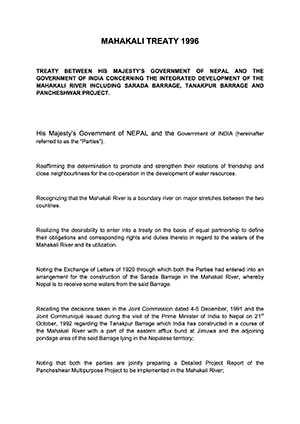Mahakali Treaty 1996
The Mahakali Treaty, signed in February 1996 between India and Nepal, pertains to sharing water of a river by the same name. Now the Treaty is in force and is in the process of implementation, although there have been ups and downs in its implementation.
The Mahakali Treaty basically aims at an integrated development of water resources in the Mahakali River and has been finalized on the basis of equal partnership. The Mahakali originates in Nepal and forms the border between the two countries for a considerable distance. The scope of the Treaty covers the Sarada Barrage, the Tanakpur Barrage and the proposed Pancheswar project. From the Sarada Barrage, the Treaty gives Nepal 28.3 cumec (1000 cusec) of water in the wet season and 4.25 cumec (150 cusec) in the dry season. This quantity is to be supplied from the Tanakpur Barrage if the Sarada Barrage turns non-functional.
Further, the Treaty also directs that not less than 9.91 cumec (350 cusec) should flow downstream of the barrage to maintain and preserve the ecosystem of the river.
On Tanakpur, the Treaty reaffirmed the Nepalese sovereignty over the land (2.9 ha) needed for building the eastern afflux bund, as well as the 9 ha of pondage area. In lieu of the eastern afflux bund, the Treaty gave Nepal the right to 28.3 cumec (1,000 cusec) of water in the wet season and 8.5 cumec (300 cusec) in the dry season; and 70 million kilowatt-hours (kWh) of electricity (as against the earlier agreed figure of 20 million kWh).
When the Pancheswar Project comes into being and augments the availability of water in dry season at Tanakpur, Nepal would be provided with additional water and additional energy. Nepal will bear a portion of the cost of generation of incremental energy. The Pancheswar Project, which was to be located on the Indo-Nepal boundary and was to be a joint project. For this project, some general principles applicable to border rivers (an important one being “equal entitlement in the utilization of the waters of the Mahakali River without prejudice to their respective existing consumptive uses of the waters”) were laid down. These were further elaborated in a document exchanged by the two Prime Ministers. The detailed project report (DPR) was to be jointly prepared in six months; the energy, irrigation and flood control benefits to the two countries were to be assessed, and the capital cost shared accordingly; the power benefit was to be assessed on the basis of savings in costs as compared with the relevant alternatives available and so on. There was to be a bi-national Mahakali River Commission, guided by the principles of equality, mutual benefit and no harm to either party. There would also be a specific joint entity to develop, execute and operate the Pancheswar Project.
There were other provisions relating to the life of the Treaty (75 years), review after 10 years, arbitration in the event of disputes, etc.
Although, the Treaty is formally in operation but the progress in its implementation has been tardy. The DPR which was to have been prepared in six months got stalled partly because of certain technical differences.
